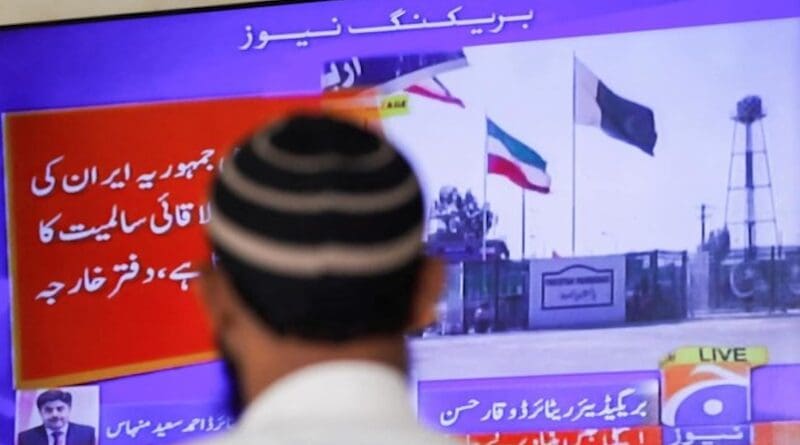Tiers Of Motivation: Bilateral And Regional Drivers Of The Iran-Pakistan Missile Strikes – Analysis
By IPCS
By Muneer Ahmed
On 16 January, Iran launched highly coordinated precision strikes in Pakistan’s Balochistan, while Pakistan retaliated on 18 January, after protesting diplomatically. These strikes were conducted across Goldsmid line, which demarcates Pakistan’s Balochistan and Iran’s Sistan-Baluchestan province. Iran hit (Sunni) Jaish al-Adl (JAA) militias and Pakistan targeted Baloch ethno-nationalist, separatist militias.
Both sets of targets operate from each other’s soil. This rise in bilateral hostilities comes amid sharply increasing tensions throughout West Asia. These reciprocal strikes draw from two factors: cross-border tensions at the Iran-Pakistan bilateral level, and Iran’s need to demonstrate a wider show of force to a range of adversaries at the regional level.
Bilateral Drivers
Historic cross-border tensions are the bilateral driver for these Iran-Pakistan strikes in Pakistan’s Balochistan and Iran’s Sistan-Baluchestan. The JAA, Balochistan Liberation Front (BLF), and Balochistan Liberation Army (BLA) militants have stoked cross-border tensions. Rising militant attacks on Iranian and Pakistani security forces have contributed to the trust deficit between the two countries. Each side holds the other responsible for turning a blind eye to militant activity conducted from within their territories. For instance, JAA is responsible for several attacks that include the killing and abduction of Iranian security forces over the past decade. Over the years, Iran has responded with cross-border strikes and warnings to Pakistan. On the flip side, Pakistan claims to have shared evidence as well as raised concerns about Baloch separatist hideouts in Iran, from where they reportedly launch attacks on Pakistani security forces.
Following the recent tit-for-tat strikes, Iran and Pakistan justified their actions by claiming to have only hit militant hideouts and not each other’s security forces, thus creating room for de-escalation. Both sides have dialled down tensions and also declared their respect for each other’s territorial sovereignty even as they sought to safeguard their national security. On 29 January, Iran’s Foreign Minister Hossein Amir-Abdollahian visited Pakistan to “rebuild ties.”
Regional Drivers
Iran-Pakistan hostilities, and the strikes, specifically, played out in the broader context of Israel’s war on Gaza, which has pitted the US and its allies against the “axis of resistance”—the Iran-backed (predominantly Shia) coalition of militant organisations. Through this network, Iran seeks to exert influence, shape regional developments, and signal and deter a host of actors: the US, Israel, Sunni militias, and Arab countries. The ‘axis of resistance’ includes the Hezbollah in Lebanon, Hamas in Gaza, Houthis in Yemen, and Iraqi and Syrian militias. In fact, US attempts to balance between de-escalating hostilities in Gaza and displaying its own military might—particularly to deter Iran and its proxies from attacking Israel—may have counter-productively motivated Iran to be more proactive.
A day before striking in Pakistan’s Balochistan, Iran fired more than 20 missiles into northern Iraq and Syria. Iran said that it was going after the Islamic State and the Israeli spy organisation, Mossad. Tehran claimed that both were complicit in the Kerman attacks, which killed around 84 Iranians earlier in January this year. As per the Iranian logic, these strikes targeted anti-Iran groups supported by opposing regimes. A domestic motivation is also likely, with Iran seeking to reassure Iranians that violence against it will be punished.
In a demonstration of the power and accuracy of its diverse missile arsenal, Iran used its Kheibar Shekan ballistic missile, with a stated maximum range of 1,450 km, in Syria. These missile attacks can also be read as an Iranian signal to Israel about the former’s range and capacity to attack. Further, targeting the JAA is a reflection of Iran’s deterrence matrix, which aims to deter not just antagonistic states but also anti-Iran militant groups in South and West Asia. For instance, Iran has long alleged that anti-Iran groups—such as the JAA—have close ties with Israel and the US, and are also supported by Saudi Arabia and the UAE.
Iran’s deterrence strategy is thus directed at and animated by four primary developments. One, it is aimed at US and UK strikes against Houthi attacks on ships in the Red Sea. Two, Western backing for Israel’s disproportionate war in Gaza. Three, hostilities between Israel and Hezbollah, and finally, Israeli forces and Sunni militants targeting Iran’s Shia proxies in Iraq and Syria. Iran is thus employing proxies to keep US and Israeli forces in the region occupied militarily, but doesn’t so far intend to engage in direct military combat with either.
Conclusion
Iran and Pakistan were motivated to engage in reciprocal military action because of bilateral, cross-border tensions. Where differences emerge is the tiers of motivation: while Pakistan emphasised its territorial sovereignty and has no reason at this time to be driven to act because of regional factors, the Iranian strikes were also a demonstration of Tehran’s ability and willingness to act militarily against a range of actors in the wider region.
- About the author: Muneer Ahmed is Senior Researcher with IPCS’ Centre for Internal and Regional Security (IReS).
- Source: This article was published by IPCS

